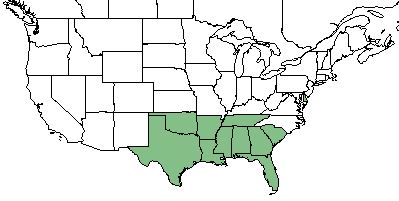Difference between revisions of "Gratiola brevifolia"
| Line 30: | Line 30: | ||
==Ecology== | ==Ecology== | ||
===Habitat=== <!--Natural communities, human disturbed habitats, topography, hydrology, soils, light, fire regime requirements for removal of competition, etc.--> | ===Habitat=== <!--Natural communities, human disturbed habitats, topography, hydrology, soils, light, fire regime requirements for removal of competition, etc.--> | ||
| − | ''G. brevifolia'' is found in sandy pinelands, oak barrens, sandy riverbanks,<ref name="Knapp & Estes 2006">Knapp WM, Estes D (2006) ''Gratiola brevifolia'' (Plantaginaceae) new to the flora of delaware, the delmarva peninsula, and the mid-Atlantic. SIDA 22(1):825-829.</ref> floodplain forests, cypress swamps, and other wet places.<ref name="Weakley">Weakley AS (2015) Flora of the Southern and Mid-Atlantic States. Chapel Hill, NC: University of North Carolina Herbarium.</ref> In the lower banks and bottoms of a ditched perennial stream, ''G. brevifolia'' consists of 1,500 individuals.<ref name="Knapp & Estes 2006"/> | + | ''G. brevifolia'' is found in sandy pinelands, oak barrens, sandy riverbanks,<ref name="Knapp & Estes 2006">Knapp WM, Estes D (2006) ''Gratiola brevifolia'' (Plantaginaceae) new to the flora of delaware, the delmarva peninsula, and the mid-Atlantic. SIDA 22(1):825-829.</ref> floodplain forests, cypress swamps, and other wet places.<ref name="Weakley">Weakley AS (2015) Flora of the Southern and Mid-Atlantic States. Chapel Hill, NC: University of North Carolina Herbarium.</ref> In the lower banks and bottoms of a ditched perennial stream, ''G. brevifolia'' consists of 1,500 individuals.<ref name="Knapp & Estes 2006"/> It is listed by the USDA Natural Resources Conservation Service as a facultative wetland species, where it is most often found in wetland habitats but can also occasionally occur in non-wetland habitats as well.<ref name= "USDA"/> |
===Phenology=== <!--Timing off flowering, fruiting, seed dispersal, and environmental triggers. Cite PanFlora website if appropriate: http://www.gilnelson.com/PanFlora/ --> | ===Phenology=== <!--Timing off flowering, fruiting, seed dispersal, and environmental triggers. Cite PanFlora website if appropriate: http://www.gilnelson.com/PanFlora/ --> | ||
Revision as of 13:43, 17 May 2019
| Gratiola brevifolia | |
|---|---|
| Scientific classification | |
| Kingdom: | Plantae |
| Division: | Magnoliophyta - Flowering plants |
| Class: | Magnoliopsida - Dicots |
| Order: | Scrophulariales |
| Family: | Scrophulariaceae |
| Genus: | Gratiola |
| Species: | G. brevifolia |
| Binomial name | |
| Gratiola brevifolia Raf. | |

| |
| Natural range of Gratiola brevifolia from USDA NRCS Plants Database. | |
Common Name: sticky hedgehyssop[1]
Contents
Taxonomic Notes
Description
Gratiola brevifolia is a dioecious annual or perennial that is a member of the Scrophulariaceae family, and grows as a forb/herb.[1] It grows erect and leafy.[2]
Distribution
This species occurs from South Carolina, southward to central peninsular Florida, westward to eastern Texas, and inland to southeastern Oklahoma, central Arkansas, and Tennessee. It also is reported to occur disjunct in Delaware.[1][3] Throughout most of its range, it is considered rare or imperiled by some,[3] but just uncommon by others.[2] While it was thought to be located in South Carolina, these populations were found to be misidentifications.[4]
Ecology
Habitat
G. brevifolia is found in sandy pinelands, oak barrens, sandy riverbanks,[3] floodplain forests, cypress swamps, and other wet places.[4] In the lower banks and bottoms of a ditched perennial stream, G. brevifolia consists of 1,500 individuals.[3] It is listed by the USDA Natural Resources Conservation Service as a facultative wetland species, where it is most often found in wetland habitats but can also occasionally occur in non-wetland habitats as well.[1]
Phenology
On the Florida panhandle, G. brevifolia flowers from March through July, with peak inflorescence in May.[5]
Conservation and Management
Cultivation and restoration
Photo Gallery
References and notes
- ↑ 1.0 1.1 1.2 1.3 USDA NRCS (2016) The PLANTS Database (http://plants.usda.gov, 02 February 2018). National Plant Data Team, Greensboro, NC 27401-4901 USA.
- ↑ 2.0 2.1 Walker J (1993) Rare vascular plant taxa associated with the longleaf pine ecosystems: Patterns in taxonomy and ecology. Proceedings of the Tall Timbers Fire Ecology Conference. Tall Timbers Research Station, Tallahassee, FL.
- ↑ 3.0 3.1 3.2 3.3 Knapp WM, Estes D (2006) Gratiola brevifolia (Plantaginaceae) new to the flora of delaware, the delmarva peninsula, and the mid-Atlantic. SIDA 22(1):825-829.
- ↑ 4.0 4.1 Weakley AS (2015) Flora of the Southern and Mid-Atlantic States. Chapel Hill, NC: University of North Carolina Herbarium.
- ↑ Nelson, G. PanFlora: Plant data for the eastern United States with emphasis on the Southeastern Coastal Plains, Florida, and the Florida Panhandle. www.gilnelson.com/PanFlora/ Accessed: 2 FEB 2018